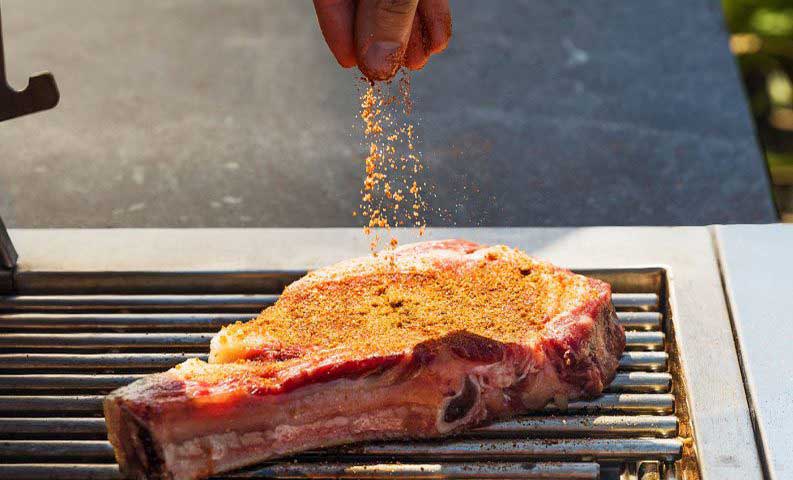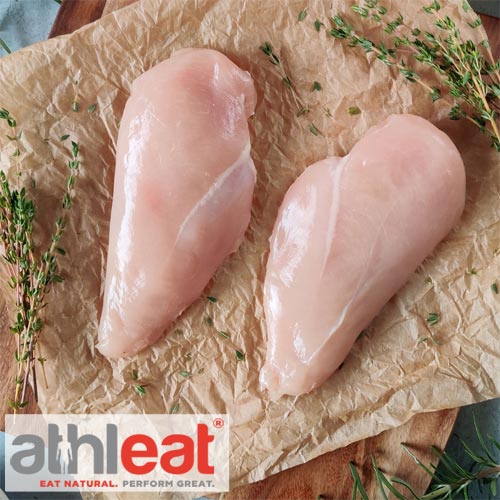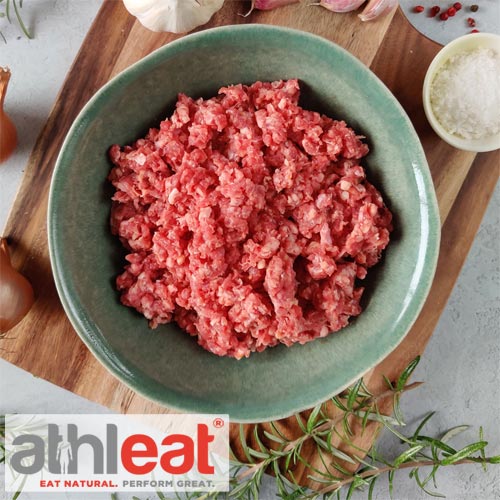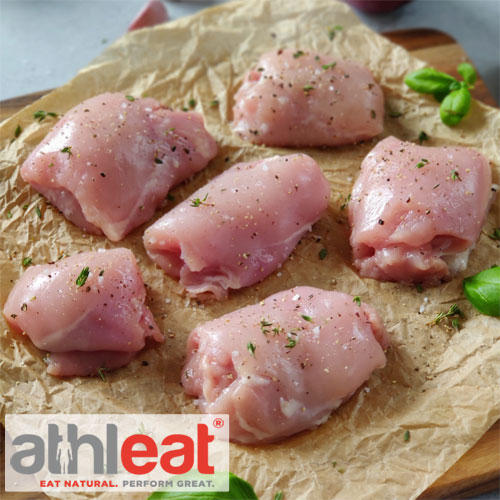Okay, so a gripe of mine are those hellishly expensive rubs you buy in supermarkets.
£1 for about 30 grams of powder? What are you going to coat with that? Maybe a few chicken wings? In reality, anyone rubbing meat meats to use a LOT to get the job done and ensure every inch of flesh is covered, they are often bizarre flavours and most people using them don’t really get much out of them
Rubs aren’t like sauces or marinate that coats your dish, powder rubs don’t stick well to skin and fat and don’t really penetrate the meat very deeply either, unlike salts, understanding why we salt and rub is key to perfecting deliciously seared, barbecued or roasted meats.
With the properties of rubs vs sauces vs marinates in mind, when using a rub, your best bet is to be rubbing the bare meat, without any sinew or membranes over the top to ensure the best coverage and to either use an oil or sauce to help it stick to the fat and skin or really work hard to get it to adhere – whatever you do, you’ll always end up with a lot of rub falling off, so rub in a high sided dish, so you can keep
Reapplying if need be.
But you know what, all these crazy expensive little rub sachets are usually just a distraction from enjoying truly well cooked, quality meat! Work with your meat, don’t mask it.
Let’s talk about rubs…
Ever tasted a raw rub? they are predominantly overpowered by salty tones, generally, because they are quite heavily based on salt!
The other tastes you’ll get will be sweetness, from sugars in the rub used to enhance flavours or aid in forming the bark and crusts on meats, the spicy tones from herbs used to both add fire and colour to meat, such as paprika, a staple on ribs for the amazing redness, herb tones usually for softer white meats and fishes and the savory taste, more and more rubs use flavor enhancers, be that garlic or even umami, all brought about by glutamate salts (such as monosodium glutamate or MSG)
Different meats tend to lend themselves to different rubs, but everything works with salt and pepper!…except maybe some fish…
Now the real BBQ alchemists like to keep their rubs salt free, choosing to add salt well before the rubbing process, then remove any excess and rub afterwards, many store-bought rubs will generally rob you of this option, but if you are buying one without salt in, then consider this method.
Salting before adding a flavour rub can have a number of benefits, the one being it dramatically reduces the saltiness of your food at the end of the cook! This is something that can add to the faff of preparation but having used this method for ribs a few times (especially smaller racks such as baby-back) I’m sold, ribs are among one of the easiest pieces of BBQ fare to over-salt with a rub.
That’s because salt is used to keep meat juicier, which is counter to most peoples belief that it draws moisture out of the meat.
Salt penetrates very lightly into the surface of the meat and acts as a draw, to keep moisture inside the meat, with the salt, not the other way around! (Unless you are heavily salting cured meats such as bacon joints.
Let me just reiterate that – PROPER SALTING HELPS RETAIN MOISTURE IN MEAT.
The rest of the spices in a rub are more like an exterior flavour enhancer, so it really doesn’t matter that much when you apply a rub again, contrary to popular belief, the rub doesn’t really penetrate deep into the meat like many think.
The salt you buy is important…. salt in flakes vs salt in grinds or large crystals
Now, my own personal experience taught me why so many favour the flaked kosher salts, besides being easier to use in the kitchen, the size and shape of the flakes give for fine coverage of meats without salting the hell out of your meat, when you use ground salt, you tend to use way more over a small area and too much salt layered into and onto the meat can kill a dish.
The classic salt-pepper-garlic rubs used in plenty of Texan style bbq often calls for about half and half salt to pepper, if you go by volume of ground or cracked black to table salt, you’re probably in for a bad time – I found this out the hard way on overly salty briskets and on ribs that ended up tasting like salty pretzel sticks,.
Salt flakes cover without being dense and are easier to handle, it’s a no-brainer, if you’re mixing up a salt pepper mix, go with flakes, and roughly cracked pepper, every time.
Anyway, as for salt flakes in the UK, if you are buying from a supermarket, you’re likely going to just find Maldon sea salt flakes, that’s what I use and that’s what I suggest you stock up on unless buying online or you have a reason to be buying in bulk
Black pepper, I prefer to buy whole corns and crack it as I need it, to ensure a fresher flavor when using it, avoid the really finely ground powdered stuff and generally avoid the hotter white pepper powder – but any sort of mix of corns will do, BBQ is about experiment, I learnt using basic SPG and that’s what I favour.
I really think very very few meats need anything more in the rubbing department, than salt, pepper, and garlic.
Other flavours I may use are onion, paprika or cumin, paired with an injection or a spritz during cooking.
Now, I dry rub pretty much everything, but I know a lot of guys out there prefer to use an oil base in their rubs as I mentioned before, to help the coatings stick and to facilitate the mixing and melding of flavours on the outside of the meat.
Remember, if you are smoking and you do this, keep it minimal. Cold and wet attracts smoke, but thick and slathered is just going to drip and run off as you cook, if you are not careful – taking with it that hard-earned smoke, but done well, you can make up a brilliant crust using a wet applied rub, in an oven it doesn’t matter as much as there is no smoke to penetrate the meat, but you still don’t want your delicious – rub to turn into expensive drips in the pan, which can also ruin any liquor you might collect if over-done.
Some people use coatings like mustard or tomato sauce for their rubs to stick, I suggest you play with it to your desire, but nine times out of ten, I’m a dry rub or a little oil man myself.
If you don’t know what to do, I suggest starting with dry rubs and a little oil, work from there.
Or maybe decide if you like sweet BBQ or tangy BBQ or just throw a dart at a map of the US and see what they do in that region and get the hang of that, if you’re a fan of pork – maybe give look into Georgia style BBQ, if you like big joints, lamb, and beef, perhaps look at Argentinian style cooking flavours and if you like bold beefy flavours, look at Texas.
The whole point of this is to love the cooking process and tuck into something you’ve made.
Cooked your way, seasoned by your hand and celebrating the flavours of the meat.
To simply get you started, I only really have two rubs I use from day to day;
Straight up Salt (sometimes, little salt due to pre-salting), pepper, garlic powder – with paprika depending on the meat.
or
Pre-salted and rubbed with a sweeter herb/garlic/oil mix
For the first rub, dust the meat with paprika, or something hotter, if you’re insane, then sprinkle over equal parts (adjusted to taste) cracked black pepper and flaked salt to taste, with garlic powder thrown into the salt and pepper to taste (classic SPG). Liberally apply this over the meat and allow it to sit before cooking, keeping it cool and wet.
For your second rub I’ll use sugar/honey, oregano, and thyme or coriander (cilantro), powdered onion, garlic, rosemary and black pepper all adjusted to taste (think of a sort of sweet honey/candied herb mix) made into a relatively paste like wash. – experiment with the mixes and make it your own, throw in mustard for something amazing for wings or legs!
I digress…
Generally, these two bases work pretty well on all meats and give powerful flavours, I don’t like to over complicate taste.
The rub needs to be simple in many cases as some recipes, like ribs for example often call for spritzing and saucing during the cooking process, so you’re going to be layering on flavour there too, depending on how you choose to cook them so again – Don’t over complicate things
The arguments and discussions behind using a brine, injecting and smoking flavours from woods is a whole other topic entirely, but ultimately if the outside of your meat isn’t cared for, you’re going to lose a whole lot of taste from drying meat to a total lack of delicious outer bark caused by the chemical reactions between the amino acids and heat on the outside (remember your GCSE science classes? – The Maillard reaction, it’s the cooks favourite bit of chemistry, giving flavour, texture and colour to dishes)
So get your simple rubs sorted, stop slathering meat in liquid marinates unless you’re cooking a stir-fry or sauced dish and embrace juicy, tender meats.
Remember,
Use simple mixes
make more rub than you think you need (total coverage with a fine layer)
Cook slow.









